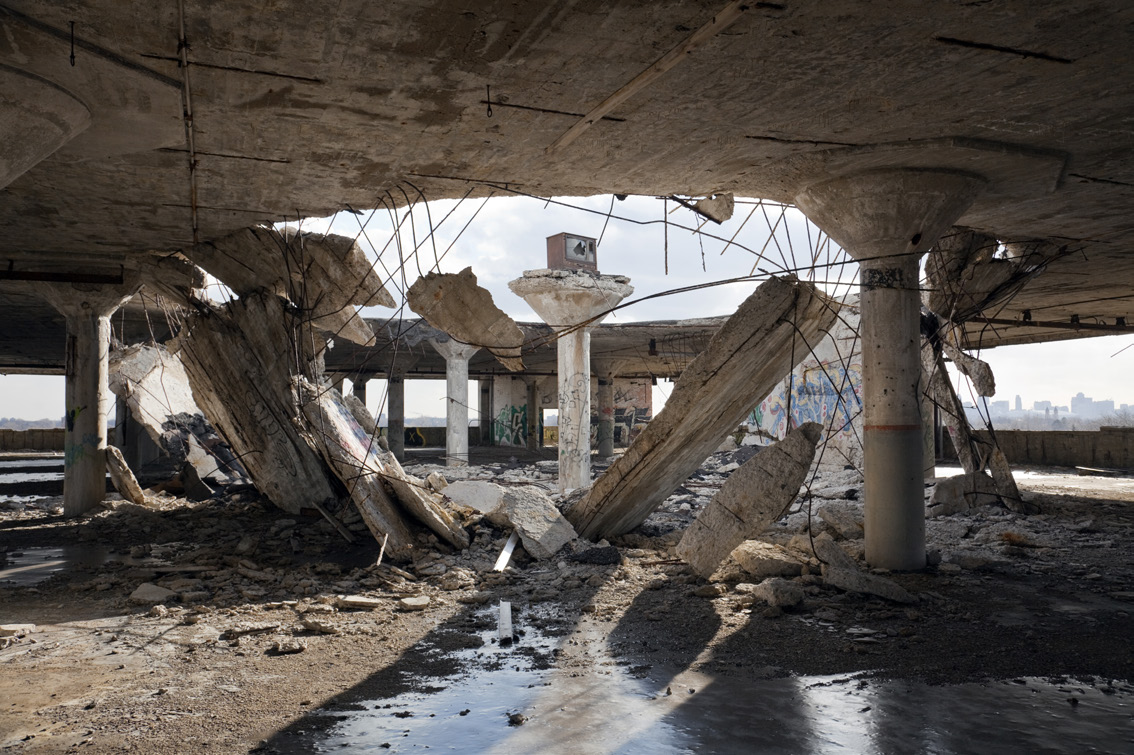Retreating / Retracing Space:
Scott Hocking and the Politics of Visibility
Michael Stone-Richards
‘Archeology’ was the only path still open to any possible ‘physiology.’
Seth Benardete
Mixing the documentary mode with lyrical fiction, The End of the World, Scott Hocking’s recent show at Susanne Hilberry Gallery, presented Detroit as a Surrealist archive.
Matt Biro, Artforum, March 2013
In geography similar to Istanbul’s –
read for Lake Huron, the Black Sea,
for the St Clair River, the Bosporos,
for the Lake St Clair, the Sea of Marmara,
for the Detroit River, the Dardanelles,
and for Lake Erie, the Mediterranean –
a natural place for Ford and Olds to open factories,
strategically tangential to the Pittsburgh steel mills,
Akron rubber plants, the Mesabi iron ore range.
Here, in ultimate concentration, is industrial
America […]
the capital of a new planet.
Lawrence Joseph, “Here in a State of Tectonic Tension”
As I write this introduction to the featured artist in this inaugural issue of Detroit Research, Scott Hocking’s work, some of the most significant work emerging from contemporary art practice in Detroit, is being shown in Detroit: Artists in Residence at The Mattress Factory in Pittsburgh; in the international exhibition The Way of the Shovel: Art as Archeology at the MCA in Chicago; in addition he recently finished a residency with new work The Quarry / Steinbruch, a site-specific installation in Wolfsburg, organized by the Kunstverein Wolfsburg in Germany, and this not long after a multimedia installation of new work, The Secrets of Nature, in April 2013 at the Museum of Contemporary Art, Detroit (MOCAD) in the context of ArtX, the biannual celebration of artists and writers who in the previous two years have won a Kresge Arts in Detroit the previous two years have won a Kresge Arts in Detroit Fellowship. Even after the influx of artists to Detroit from Europe, Los Angeles, San Francisco, Chicago, New York and elsewhere, there is a very small handful of artists in Detroit with this kind of national and international reach whose work is also at the cutting edge of thoughtful and innovative art. Of the artists in Detroit who have achieved national and international recognition Hocking is one of the few – Michael E. Smith would be another – to have developed a distinctive new language and form of representation, one, furthermore, that necessitates the correlative development of a critical response or critical theory. Another claim, however, can be made of Hocking’s work in addition to the national and international recognition which it is receiving, and that is that his may be the representative art of the recent and emerging Detroit scene for the way in which it encompasses a thinking of the city as practice in transdisciplinary forms across sculpture, installation, walking, photography, the pursuit of sedimented layering in archeological and archival research, and the research into the retrait / retreat of cultural presences through an investigation of latency in spatial sites.
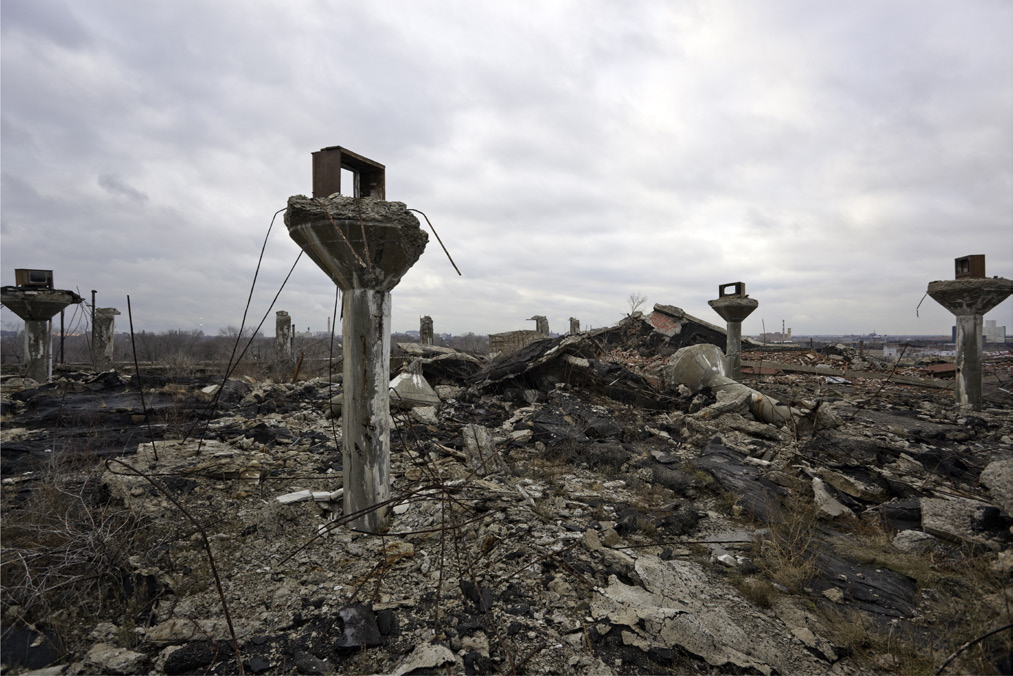
Garden of the Gods, West, Winter – from
Garden of the Gods, 2009-2011
By representative I intend above all that Hocking’s work is both deeply rooted in the historical conditions of the city of Detroit (the question of place, thus) and simultaneously participates in the international language and forms of contemporary art (and thus the meta-discourses of contemporary art). When these two conditions are met the work of Scott Hocking emerges as one of the most compelling of a relatively small group of significant talents focused upon the conditions of representation through the expressivity of constructed, historically manipulated – and sedimented - artifacts. Even when artists make it their task to do away with representation, to work in some way directly with or upon reality, to expose or de-mystify the conditions of spectacularity, it remains that representation is the necessary encounter, and Hocking’s work is one of those, in Detroit, that fully articulates representation as the principal problem of thinking in art. It is for this reason that in the inaugural issue of this new journal Detroit Research Hocking’s work is featured in depth as the representative artist of the new modes of art practices emergent from Detroit these past fifteen years or so.
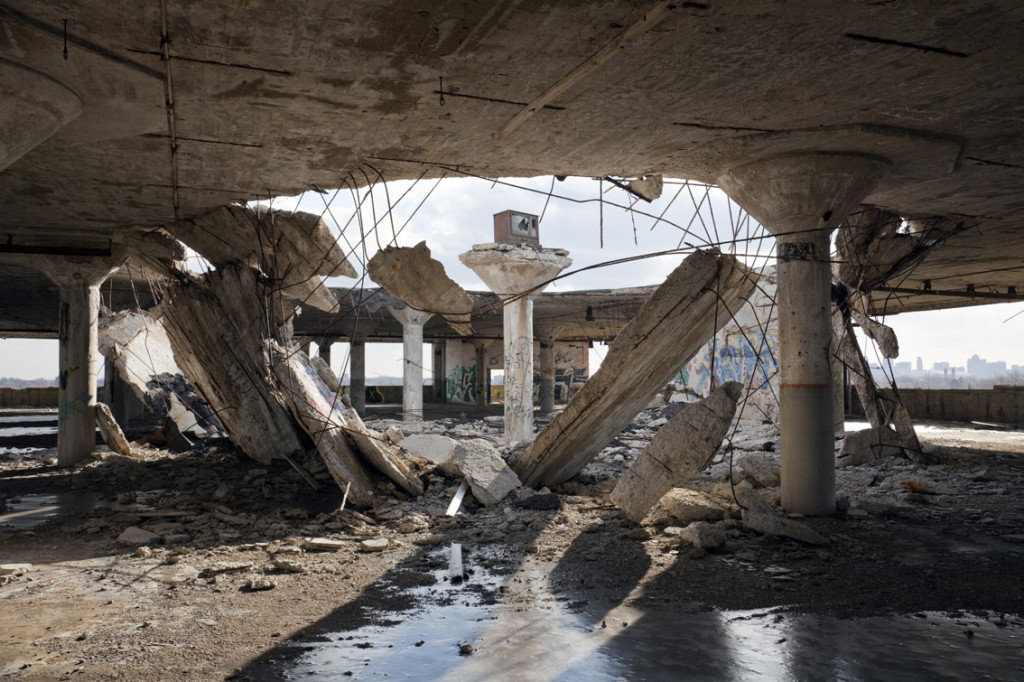
Garden of the Gods, Zeus, Ice – from Garden of the Gods, 2009-2011
First, what do I mean by the new forms of art practice emergent from Detroit these past fifteen years? Though there is much art of quality in Detroit, the form of art practice for which Detroit is increasingly gaining attention outside Detroit is predominantly post-Studio art of which Social Practice has become the dominant form. Hocking’s art is not at all a form of Social Practice, but it is, with Social Practice in its Detroit form, a practice based within the city, is, indeed, an art of the city, where the city is taken as a historically conditioned and sedimented medium.1Another artist with whom Hocking can be compared, in being an artist who takes the city as a medium, whose work is a sustained engagement with the … The critical edge in Hocking’s work is the role of research and investigation, above all as this leads to one of his principal subjects, an investigation of the conditions of representation as this bears on what the poet Jim Gustafson famously called the idea of Detroit. In doing so, Hocking’s work – in Iceland, Australia, Germany, Detroit, Philadelphia, St Louis, and other venues in North America - uses archival research, archeology, anthropology, social geography, walking, site-specific installation, and photography as means of simultaneously constructing, capturing, and investigating the processes by which forms within the city and “nature” emerge, become depleted, ruined, displaced, and finally cast off in processes of de-differentiation. If Hocking’s was a traditional art practice we should speak of genres of landscape, still life, etc. His is not, however, a traditional art practice, so it is better to speak of the way in which certain forms assume the provisional status of genre: for example, the factory as a genre, where it is understood that the factory in Hocking is not a genre of photography but more a form with a (manipulable) history, a sense of inside and outside constructed by the artist through the complex patterning and inter-weavings of collection, installation, photography and, importantly, the work of the hand as witnessed in a series such as Sisyphus and the Voice of Space, 2010.2The way in which Hocking’s practice of the city situates itself in relation to painting and especially Surrealist painting bears comparison with … Part of the title, “The Voice of Space,” is an allusion to a painting series, La Voix des airs / The Voice of Space, c.1928-1931, by the Belgian Surrealist René Magritte, by which Hocking makes clear that his concern is not with documenting (through photography, say, a factory) but with representation, and thereby construction or figuration. Other examples of the way in which forms assume the status of genres is Hocking’s great exploration of / and installations within the Albert Kahn designed Fisher Body Plant one of which is the already iconic series called the Ziggurat, 2007-2009; closely related yet distinct is the city in the series Garden of the Gods, 2009 – 2011. This series consists of installations made from materials onsite – reinforced concrete columns, with broken, used televisions atop the columns – on the collapsed roof of the Packard plant as though the installation and constructed imagery captured a mythic landscape in snow, in a field of ruins, even, at one moment, the exposed metal supports in the re-inforced concrete of collapsed roof and columns positioned at a distance just right to make the resultant configuration appear like a form of drawing, in other words, the work of distancing inherent to the project is there to make the experience not an image but a construction. Here a number of Hocking’s concerns and practices converge in construction (walking, surveying, recuperation, the work of the hand with on-site available materials, process sculpture, investigation of site-specificity and spatial form as result of varied historical sedimentations, the photograph as (partial) indexical record, or witness, and artistic artefact for attentive engagement) bearing upon the problematic of ruination and the archeological. But what, in the context of Detroit industrial and cultural histories, is a ruin? For there are ruins and ruins, as the great psycho-analyst and writer J.-B. Pontalis once observed remarking on the need to recognize the type of temporality linked to a certain type of attentive engagement in the idea of ruins especially as found in the ancient relation between paintings, ruins, and wrecks (naufrages) in a logic of fragmentation. Here is the comfortable idea of ruins:
There are ruins and ruins. Those propitious to gentle melancholy, to nostalgia: the monument – temple, castle, dungeon, abbey… - already sacred or noble from its origin [...] There is a whole pictorial tradition of ruins and wrecks:3On this pictorial tradition of ruins, see the recent Tate Gallery exhibition Ruin Lust (with artists ranging from the painter Turner to the … the alliance of painting and of ruins in their power of evocation of what is not, of what is no longer observable from end to end under our eyes.4J.-B. Pontalis, “Le Souffle de la vie,” Ce temps qui ne passe pas (Paris: Gallimard, 1997), 126. My emphasis.
One goes to Rome, to certain parts of England or Germany, to be enchanted by the remains of monasteries or once great houses or the intentionally left fragmented remains of war (Oradour-sur-Glane in France); the Imperial Garden in Beijing; may be, even, one visits Colorado and the Garden of the Gods there, or Utah with its pre-historic rock formations to allow the mind to play with the making visible of the passages and ravages and so many losses of time5The locus classicus for this form of reverie upon the ruin is Rose Macaulay, Pleasure of Ruins (London: Thames and Hudson, 1964). A more current … – for each human loss in time is a loss of a possible human future as Guy Debord never ceased to force home in the ethics of temporality he made central to his account of liberty. Here, though, is an other fragment, the gaze upon which does not allow the mind an equally easeful playful absorption:
But to wander in a damaged and shelled city, in a destroyed neighborhood deserted by its inhabitants overwhelms us. The vision of a work-place left in abandonment discomforts us: this house, then, will never become finished! Why has its construction been stopped? What a failure! It is dead before being born, it is abject waste, never having achieved the moving status of relic, or remains. Incomplete, but incomplete forever, as it will never have been granted the time to become a ruin.6Pontalis, “Le Souffle de la vie,” 127.
In this form of fragment there is abandonment, and time seems not to have touched it, the remains, the ruin-object or fragment, sufficiently for it to become; it is, indeed, stunted and with it the temporality becomes what Debord, following Eugène Minkowski and Joseph Gabel, characterized as a damaged or coagulated temporality.7Cf. Guy Debord, The Society of the Spectacle (Detroit: Black and Red, 1977), thesis 35. This fragment does not even achieve the status of a relic which, in analytic terms, is part of a logic of separation in which the relic-object, in veneration, allows the dead to be dead (separated) so that the living may continue living (transmission) – in other words, to use the colloquialism, there is no closure, and this fragment interrupts us in our otherwise free, unthinking movements, and makes us almost internalize its projected resistance. The ruin-object in Detroit has, though, received time, has been a forum of interaction, but it has been, primarily, economic time, the time of the commodity, and so the ruin in such a context may be defined as the shell left behind after the massive and irreversible transfer of capital (social energy) away from the City, and its social networks or arteries, a city ill-equipped for the arrival of globalization. The resulting shell is not devoid of significance, community, or history, hence the language of re-treat (withdrawal, fading, concealment, disguise, obscuring) and the related work or dérive in urban margins so present in Hocking’s art practice.8Cf. Philipe Lacoue-Labarthe and Jean-Luc Nancy, Retreating the Political (London: Routledge, 1997). In many respects, the irritation felt by some at others’ fascination with the ruin-objects of Detroit is a reaction- formation at becoming voyeuristic objects 9The term “ruin porn” being utterly vacuous and void of conceptual content. In short, it explains nothing, and is a mere protest at being looked … – but all this does, in a strange way, is show the manner in which the voyeurism built into the origins of the Western camera has now turned its gaze from exotic “others” to ourselves. In other words, one suddenly feels what it is like to be looked at at the very moment that resources, which once were drained from other-places, are now drained from us ourselves and our social and ecological environments of sustenance. This process started with native-Americans and is commemorated in Hocking’s Garden of the Gods. The title of this series, Garden of the Gods, alludes to rock formations to be found in Colorado and Illinois which, as the poet Robert Hayden wrote, in his “[American Journal],” were sacred. Here is how Hayden, in the persona of an extra-terrestrial alien anthropologist visiting earth in Colorado, puts it:
much here is
beautiful dream like vistas reminding me of
home item have seen the rock place known
as garden of the gods and sacred to the first
indigenes red monoliths of home. 10Robert Hayden, “[American Journal],” Collected Poems (New York and London: Liveright, 1996), 192-193. Less accessible but important for its …
The “first indigenes” are long gone, their culture devastated, available only in fragments, ruins, and even their burial mounds buried over, open, or re-moved, barely visible, if at all, in the conceptual realm alone. But the first indigenes are followed by others who in turn are followed by others and each leaves behind a City more complex, more rich with affect, ruins, relics, histories, and lives layered in oblivion and forgetfulness, the process of making oblivion gaining speed. 11Cf. Norman M. Klein, The History of Forgetting: Los Angeles and the Erasure of Memory (London and New York: Verso, 2008). Hocking’s practice is less about mourning such passage than commemoration, but even more than commemoration – as recorded in the Babylonian epic the Enuma Elish, the Ziggurat in its original Mesopotamian function, after all, was a form of celebration of victory over an enemy and the establishment of a sacred place upon that defeat12The most significant aspect of Marduk’s victory, in whose honor the first Ziggurat was built, as recorded in tablet VI of the Enuma Elish, is the … – his practice, rather, is an un-veiling of oblivion and forgetfulness as though, in the Garden of the Gods, the columns are upshoots of a buried past, rocks amongst the greenery, the detritus of industry amidst the dashed, broken hopes of a life predicated upon consumption, the broken T.V.s testimony to some timeless rite of celestial communication: messages from the stars – celestial and inter-stellar communication as the earthly stars become deified and refined into images for transmission – or the gods (not captains) of the universe. It is as though the installation (upon which one chances within the frame of the Packard Plant) and photography record a kind of secular orogenesis embodying the interaction of man’s play and industry/labor for which art and consumerism are curious doubles of each other in the staging of forgetfulness and oblivion … from Colorado (a Spanish name for the Colorado River), through Illinois (a French transliteration of a native-American name) to Detroit (from the French Détroit for the straight of Detroit)13No surprise, then, that one of Hocking’s finest essays is called “A Nice Spot Along the Water.” See below, 44-48. and its many burial grounds whose re-treat is the subject of The Mound Project.
“The work is not put in a place, it is that place.” Robert Smithson, Avalanche, Fall, 1970
Above all, however, Hocking’s languages and forms – drawing upon the materialist dimension in archeology, anthropology, and natural history – point to an over-riding preoccupation, namely, the politics of (in)-visibility. I do not know if there is an archeological turn or imaginary in recent contemporary art as Dieter Roelstraete, who curated Hocking into his MCA exhibition The Way of the Shovel: On the Archeological Imaginary in Art,14Cf. Dieter Roelstraete, The Way of the Shovel: On the Archeological Imaginary in Art (Chicago and London: Museum of Contemporary Art and University … has argued since his 2009 e-flux article on the topic, but I am quite sure that there is in contemporary art and related meta-discourses a powerful preoccupation with the politics of visibility – Chantal Akerman’s cinematic meditations on demographic movements (from D’Est in 1993 to De l’autre côté in 2002 and Là-bas in 2006 ), and Alfredo Jaar’s Let there be Light: The Rwanda Project (1994-1998) will suffice15See below “Notes on Biopolitics,” 132-138. – and further that archeology has become one of the figures of this preoccupation, in a manner consistent with yet differing from Robert Smithson’s figures of the archeological.
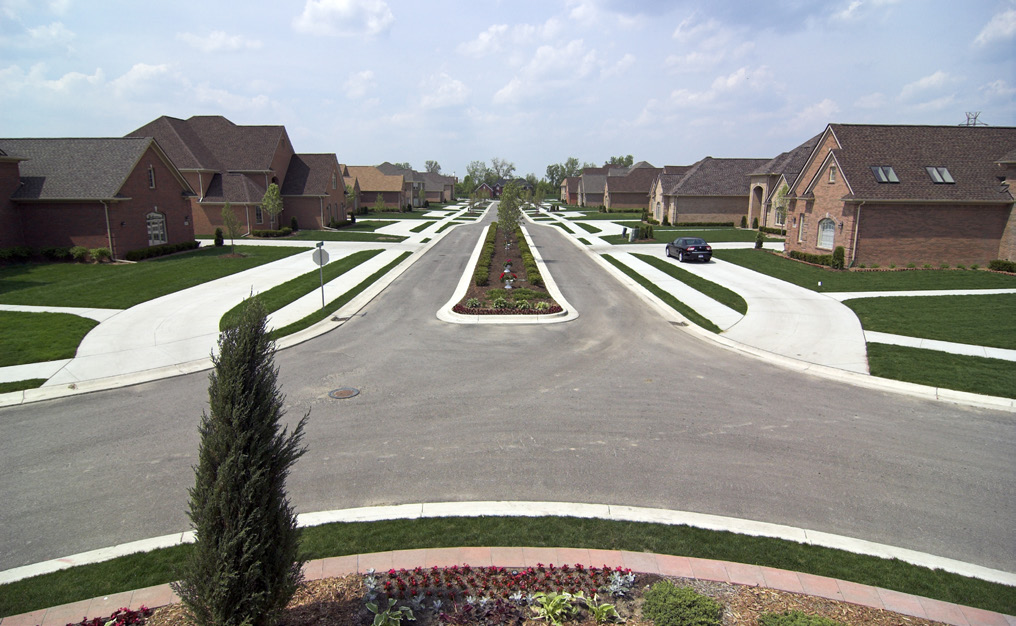
The Mound Project, Morgan Estate, North – from The Mound Project, 2007-present
It is in this light that it becomes powerfully clear that Hocking has developed a distinctive practice calling for its own critical language, for the whole utterly misinformed talk in Detroit and certain places about the photography and representation of ruin-objects, ruins and ruination has detracted from, wholly missed, the principal concern,16For a sophisticated treatment of ruination as a problematic, and not as some trite response to outsiders’ fascination with decline and decay, cf. … a concern which is central to Hocking’s developing practice, for Hocking’s work shows its criticality through the engagement with and investigations of the politics of visibility, through the ways in which the dis-appearance of appearance is staged (this is the retrait / re-treat), how erasure becomes manifested, and there is no clearer example of this than the series The Mound Project, 2007 – present, which attempts to point (for words are not readily available) to the creation of oblivion through the erasure of sites of memory (in this case, the removal, displacement, or destruction and eventual devastation of pre-contact burial mounds in Detroit) only to be “replaced” by (or re-treated as) brownfields, factories in turn become redundant, blight, wasted lives, with all (or most) visible evidence of the past erased as part of a process of cultural devastation, that is, where destruction and erasure become irreversible at the cultural level and so permanently disruptive of transmission.
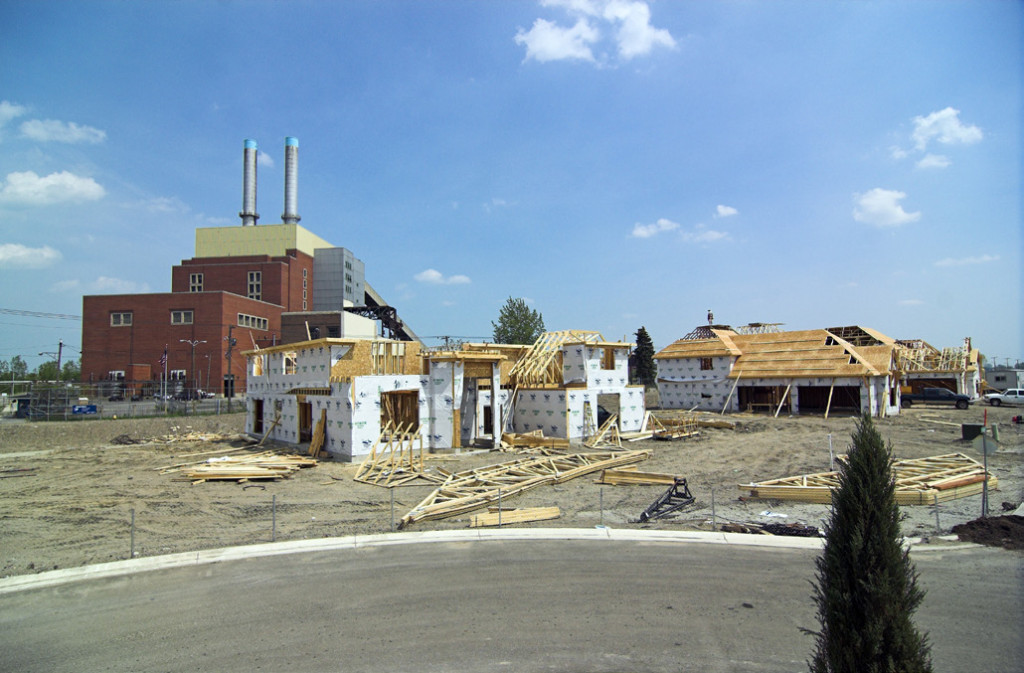
The Mound Project, Morgan Estate, with Two Brothers
– from The Mound Project, 2007-present
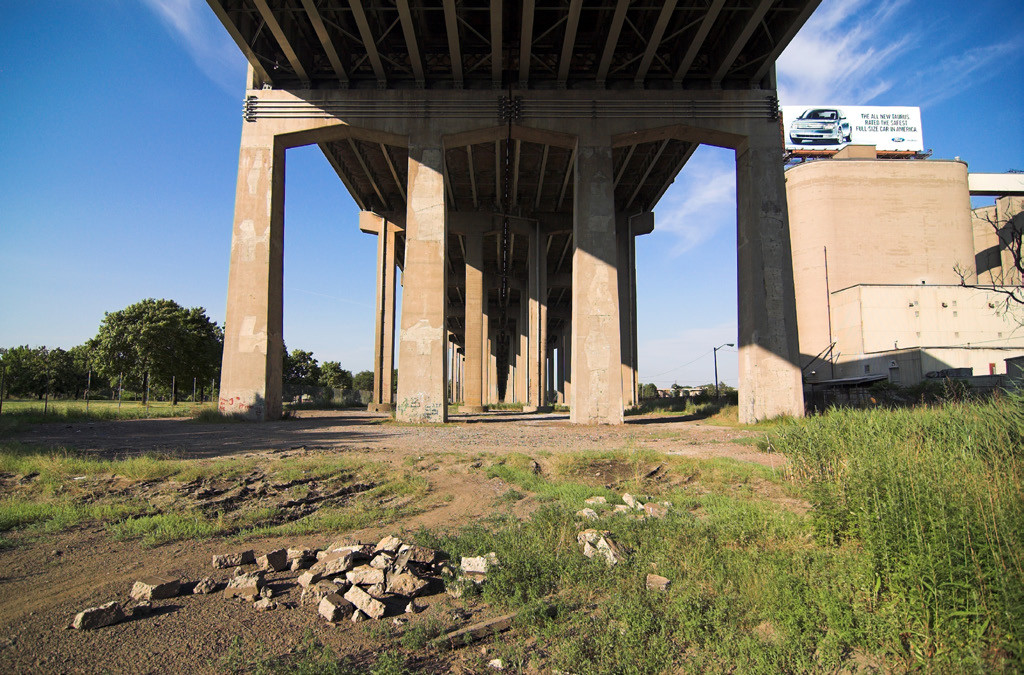
The Mound Project, Under I-75 – from The Mound Project, 2007-present
It is no surprise, indeed, it is a logical extension of his developed and developing language and forms, that this approach to the politics of visibility should lead him, in a newly begun project, in an act of re-tracing, to a quasi-archeological and social-cultural investigation of the area of Detroit called Black Bottom, one of the most poignant and still felt sites of erasure of African-American culture in Detroit, removed in the name of urban renewal and now the site of the Mies van de Rohe complex of apartments in Lafayette Park. The Mound Project in its treatment not of mere absence-presence (after all a relatively crude binarism) but rather of the retreat from representation into invisibility has prepared the way conceptually and perceptually for the kind of phenomenological and historical intuition of erasure, retreat, retracing and, finally, devastation (rather than mere destruction from which it is possible to recover). We see, for example, the I-75, like a looming esence, a beast, a weight, even, holding its appropriating presence over the once lived in land vacated, then devastated by eminent domain, and we are invited to construe the surrounding negative space dialectically and so precisely not as mere absence against a supposed presence but as an active historical configuration whose resonance and vibration – that tone of the neutral, the bland as we grasp it in The Mound Project, Morgan Estate – have found visual density in the photo-graphein / light-writing of Hocking’s practice. Likewise shall we be required to see the gracious Lafayette Gardens – like the manifestly ugly and beast-like I-75 – as contemporaneous forms of cultural burial grounds…but also come to recognize that this is the City, where the living is complicit with the dead. I could quote Sophocles’ Antigone or Simone Weil on precisely this point, but may be the Anglo-Nigerian writer Ben Okri says it in a late modern diction when, in his “A Prayer from the Living,” which opens Alfredo Jaar’s Let there be Light: The Rwanda Project, we find it said by the dying man in the City of Man: “And when I looked at the body next to me and found the luminous unfamiliarity of its face to be that of my lover’s – I sang all through the recognition." 17Ben Okri, “A Prayer from the Living,” in Alfredo Jaar, The Rwandan Project: 1994-1998 (Barcelona: Actar, 1998), no pagination. The post-Industrial City, however, bears within itself this difference, namely that is it is marked by oblivion, that is, forgetfulness, hence the politics of (in)-visibility so prominent in contemporary practice and in Hocking’s development of this preoccupation in his Detroit-based work.
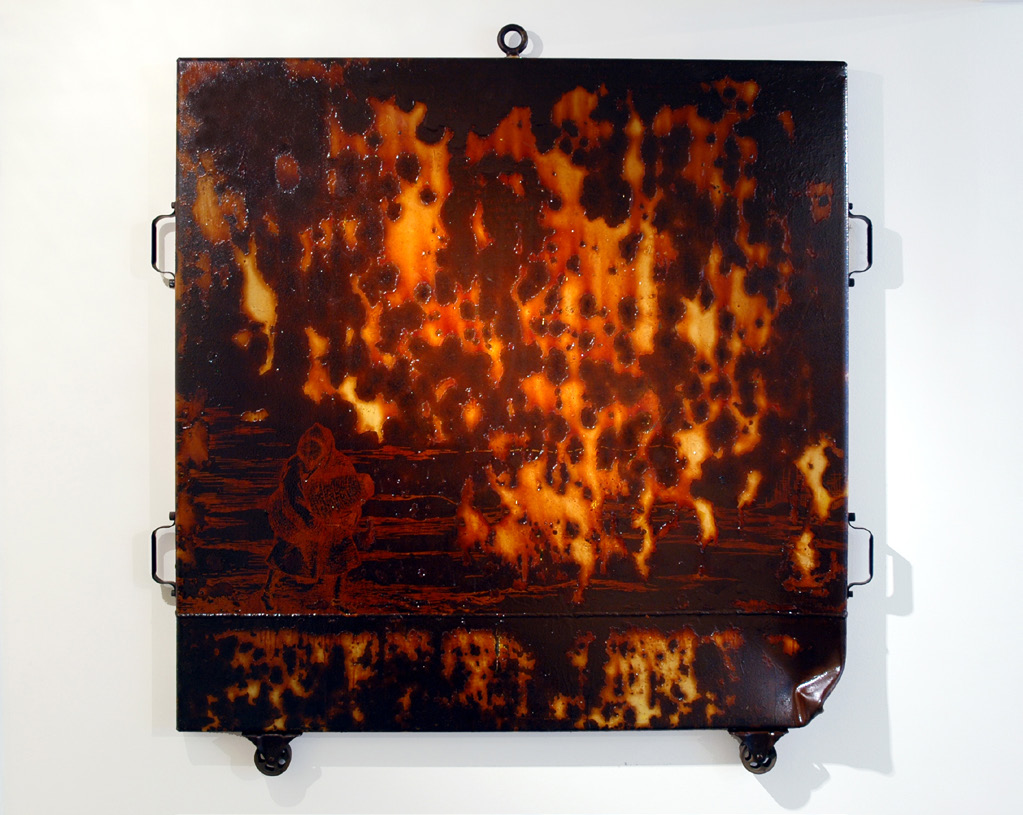
Alchemical Works, The BeeKeeper – from Alchemical Works 1997-2006
There is, last but by no means least, another aspect to Hocking’s artistic practice, an aspect which is based in the Detroit habitus and which also shows him thinking in terms of the history of art. When, in October 2010, Matthew Barney and Jonathan Bepler came to Detroit for the creation of their opera KHU, whilst experiencing the duration of the work (an approximately twelve hour event from beginning to end) something obvious hit me with a force which hitherto I had never felt, at the precise moment of the raising from the Rouge River of the god Osiris under the form of the engine of the Chrysler Crown Imperial surrounded by a form of keening – led by Isis - with which one is no longer accustomed in the Western tradition, namely, that Barney’s work is not first and foremost a semiotic venture but is rather firmly anchored in the ancient – and renewable – conception of the analogical imagination. The engine of the Chrysler Crown Imperial is a god. 18Cf. Michael Stone-Richards, “Coda: And what would a god look like, anyway? Matthew Barney in Detroit,” Care of the City: Detroit and the Question … (Surrealism was the last great renewal of this mode of working with the analogical imagination, 19Matthew Biro has written a review of Hocking’s Susanne Hilberry show End of the World in which he pointed to the presence of a Surrealist … since which time artists such as a Beuys or an Abramović have developed distinct strategies that are variations of analogy as practice aimed at breaking, frustrating or problematizing the mirroring tendencies inherent in human projection.20The problem of the Ströher Collection of Beuys’ work in the Hessiches Landesmuseum, namely, whether it should have been left exactly as Beuys … What could easily be seen as the movement of the signifier in Barney’s work could also and more plausibly be grasped as the movement of forms and analogy in a distinctly fabricated (manipulable) analogical space. (The Garden of the Gods, The Mound Project are analogical spaces figured through materialist practices.) Then it was that it struck me that the only artist in Detroit for whom the analogical mode was still available, that is, an operant set of reflexes and forms, was Scott Hocking – his last one-person show, The End of the World, at Susanne Hilberry, was nothing else with its Mercury motor car (the literal and the figural simultaneously), held in salts (again, the literal and the figural), its installation of a wall of books each cover of which bears on the topos and form of the end of the world and nearly all of which are alchemical or available to an alchemical movement; and throughout one encounters in the exhibition and the related work that fundamental alchemical disposition that the world is a system of symbolization in which everything (large and small, high and low, inside and outside, before and after) is interconnected and thus a system in which all is mutually translatable. The old tradition of alchemical thought believed that there was a key for all this – nineteenth-century alchemy in its Symbolist as well as non-Symbolist modes is one of the most curious forms of positivism ever invented! – but after Surrealism and up to Abramović and Barney there is no key to a book of symbols but only movement and transformation, matter as mode. Hence the great saying by Breton in the essay on the peu de realité (the paucity or little that there be of reality) that the world is only limited by the poverty of our imagination, for what the analogical mode seeks is the open for the play of the imagination, and, in a mode predicated upon mutual translatability, anthropological equivalence or balance without mere mirroring, that is, a mode in which terms may be brought into material equivalence, but not tautology. This is the work of Barney’s Drawing Restraint 9 (35 mm color, 2005). We see this mode of attention in Hocking in the photographic series called Detroit Nights, 2007 -, something present from the earliest stage of his professional life as an artist with the Alchemical Works, 1997-2006, the techniques and modes of which are brought to bear upon the materialist work based in Detroit and the Packard and Fisher Body Plants, for example, the Fisher Body 21, Night Window, 2007-2009 whose use of reflecting light upon a horizontal surface fulfills a similar effect to the broken mirroring devices to be found in late nineteenth-century painting such as Paul Serusier’s The Talisman, 1888, oil on panel (Musée d’Orsay), and which were one of the principal formal sources in the emergence of abstract painting (and so abstraction as thought) in the tradition of both Kandinsky and Mondrian. We see the same devices at work in Atget in photographs such as l’Ambassade d’Autriche, rue de Varenne, 1905 and Saint Cloud, June 1926.
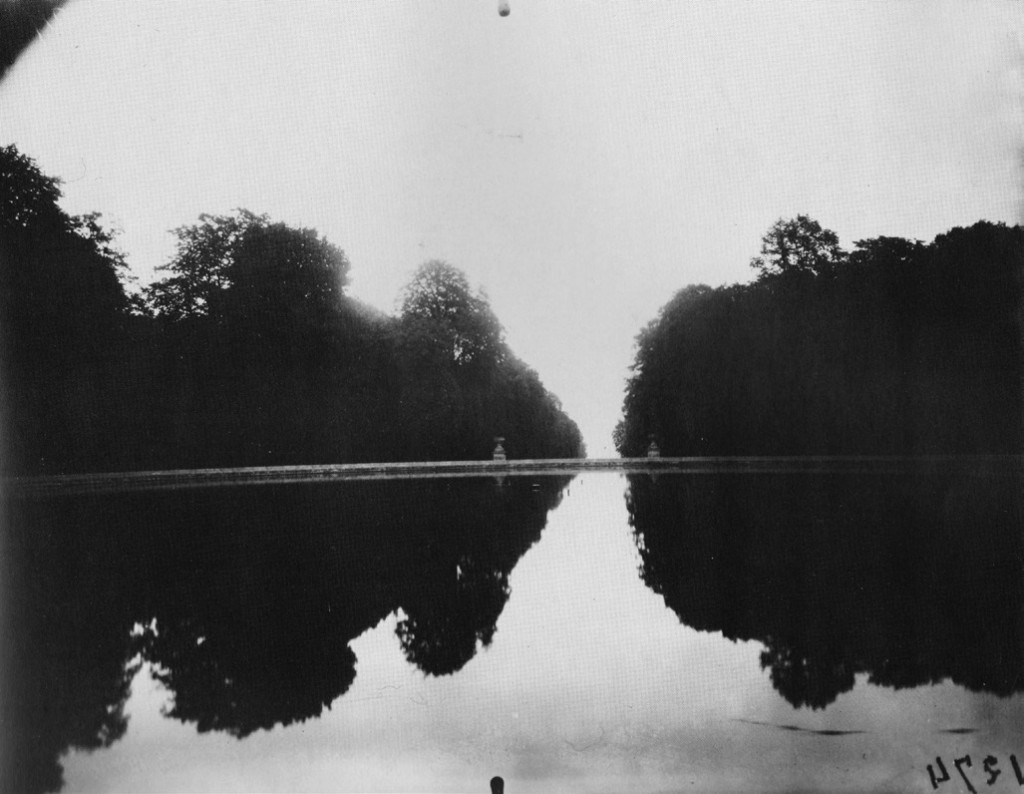
Atget, Saint Cloud, June, 1926, public domain
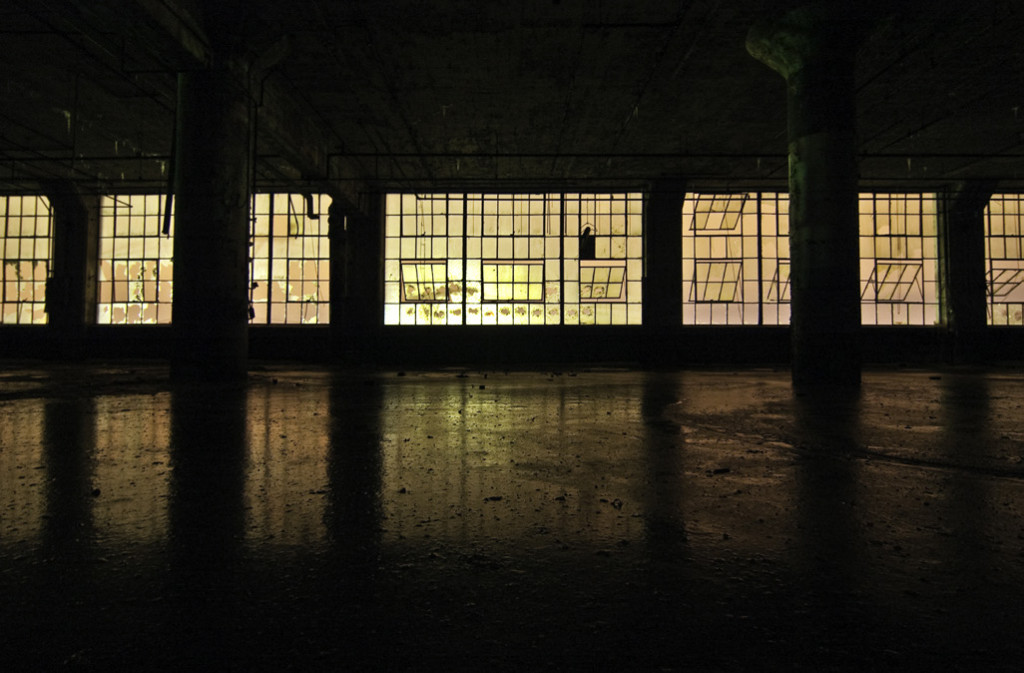
Fisher Body 21, Night Window, 2007-2009
The fundamental aesthetic transformation is that of matter with experience. The way in which the raw material of the Fisher Body has been transformed through light into Night Window not only re-affirms such strategies about the role of form in the transformation of matter, but shows, too, how the analogical imagination is still at play, even, and may be, as Barney showed, especially in Detroit.
It is in this criticality and historicity that Hocking is at once of Detroit yet part of a powerful set of languages in international contemporary art. In this issue a number of writers – Lynn Crawford, Sarah Margolis-Piñeo, Glenn Mannisto – share their take on Hocking’s work. Hocking, too, is a fine writer and researcher and some of his writings have been brought together and placed in dialogue with other works such as Biba Bell’s reflections on Belle Isle and domesticity, Vince Carducci on the art of the commons, or Barrett Watten on the poetics of ruined space in order to evoke new echoes, suggestions and critical strategies.
In this issue a number of writers – Lynn Crawford, Sarah Margolis-Piñeo, Glenn Mannisto – share their take on Hocking’s work. Hocking, too, is a fine writer and researcher and some of his writings have been brought together and placed in dialogue with other works such as Biba Bell’s reflections on Belle Isle and domesticity, Vince Carducci on the art of the commons, or Barrett Watten on the poetics of ruined space in order to evoke new echoes, suggestions and critical strategies.
References
